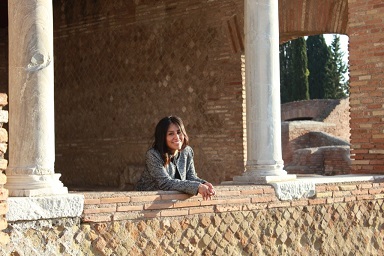Staff profile
Katerina Gottardo

| Affiliation |
|---|
| Member of the Department of Classics and Ancient History |
Biography
I completed my BA in Archaeology and MA in the Science of Archaeology at the University of Padova, where I also attended the first year of the classical curriculum of Scuola di Specializzazione in Archaeology. During my BA and MA, I took part in several excavations across Italy, mainly in Aquileia where I worked for many years, but also in Siena and Cuma. I also worked in commercial archaeology in Italy. Recently I took part in the stratigraphical analysis campaigns in the ‘Rome Transformed Project’ (Newcastle University, Università di Firenze, BSR, CNR) and the excavations under the ‘Falerii Novi Project’ with the BSR.
My field of specialization is Roman Archaeology, focusing more specifically on architecture. My BA thesis, ‘Material and building techniques of Roman structures in the province of Venice’ (supervisors Prof. A.R. Ghiotto and Prof. C. Previato) examined the materials and construction techniques used in the province of Venice during the Roman Republic and Empire. This research was part of a larger project (Archeoed) whose aim is to create a catalogue of all the building techniques used in Cisalpina during the Roman times. After my MA thesis, ‘Substructures of Roman theatres in northern and central Italy’, I developed an interest in theatrical buildings and hydraulic structures.
My doctoral research, motivated by prior studies, and for which I have been awarded AHRC funding via Northern Bridge, is entitled “An investigation into the hydraulic installation of Ostia and Pompeii as contribution in understanding aquatic performances in Roman theatres”. This research is being conducted under the supervision of Dr Edmund Thomas (Durham University), Dr Erica Bexley (Durham University), Prof. Ian Haynes (Newcastle University), and Dr Davide Motta (UCL).
Research Project
“An investigation into the hydraulic installation of Ostia and Pompeii as contribution in understanding aquatic performances in Roman theatres”
It is well known that Roman amphitheatres could be used for water displays, the arena filled with water to mimic sea-battles or other performances (Coleman 1993). Less well known, however, is the use of theatre buildings for water spectacles. Gustavo Traversari (1960) was the first to consider this theme closely, hypothesizing a type of performance called the ‘tetimimo’; and, more recently, Anne Berlan-Bajard (2006) has extended his work, establishing that such water displays took place well before Late Antiquity. Nonetheless, they remain disputed in nature, lacking proper definition, and, above all, close approximation to the archaeological evidence. Indeed, recent monographs on theatres (Rossetto and Pisani Sartorio 1994, Sear 2006) do not sufficiently treat the architectural elements that made water displays possible, and modern architectural handbooks (Gros 1996) underplay the role of water in Roman performances. Evidence for the supply of water to theatres remains generally neglected.
The present research project will focus on aquatic installations in Roman theatres, adopting up-to-date architectural methodologies for the study of buildings, such as structural and stratigraphic analysis and photogrammetry, and considers engineering aspects to understand these installations, as well as the sewerage system of the building. It will also illuminate the cultural influences in the Roman Empire that catalysed architectural changes in theatres, making possible the performance of water shows. The project will consider those installations related to specific aquatic uses in order to formulate hypothesis on the operation of the water system in Roman italian theatres from the Early Empire up to Late Antiquity.
Recent Conference Presentations
(2023) 'Architetture e sistemi costruttivi dei teatri e degli anfiteatri antichi nell'area adriatica', Internationa Workshop, Padova (December). Paper title: 'L'acqua nei teatri: una panoramica'.
(2023) 'European Association of Archaeologists' (EAA 23)' (August). Paper title: 'The underground structures of the theatre in Ostia: a preliminary study'.
(2023) ‘Theoretical Roman Archaeology conference (TRAC 2023)' (April). Paper title: 'Understanding the water management in the theatre of Ostia: an interdisciplinary approach' co-authors: Edmund Thomas, Ian Haynes, Davide Motta.
(2022) ‘Assessing Roman large-scale hydraulic systems. Data integration for large-area research’, a Rome Transformed online colloquium, Newcastle (May) (organised by Newcastle University, Università di Firenze, BSR, CNR). Title of the paper: ‘Hydraulic systems in Roman theatres: the transformation of the theatre in Ostia’.
(2021) CIfA 2021 annual conference – Early Career Researches (April). Poster of my PhD project.
(2021) 18th Annual Postgraduate Forum Interdisciplinary Conference, titled ‘Adaptation’, Newcastle University, School of History, Classics and Archaeology (May). Title of the paper: ‘Adaptation to the environmental context: the substructures of caveae in Roman theatres in the northern-central Italy’.
(2021) ‘Terra, legno e materiali deperibili nell’architettura antica’ / ‘Clay, Timber, and perishable materials in Ancient architecture’, Convegno internazionale di studi, Padova (June). Poster title: ‘I terrapieni nei sistemi sostruttivi dell’architettura teatrale’.
(2021) CIfa Innovation festival 2021 (October). Presentation of my MA thesis.
Publications
Chapter in book
- The underground structures of the theatre in Ostia: a preliminary study on the sewerage systemGottardo, K. (n.d.). The underground structures of the theatre in Ostia: a preliminary study on the sewerage system. In Ancient water supply and management systems in the Western Mediterranean: construction and operation [Contracted by publisher]. Archaeopress.
Conference Paper
- L'acqua nei teatri: una panoramicaGottardo, K. (in press). L’acqua nei teatri: una panoramica. In Architetture e sistemi costruttivi dei teatri e degli anfiteatri antichi nell’area adriatica. Edizioni Quasar.
- I terrapieni nei sistemi sostruttivi dell’architettura teatrale nell’Italia romanaGottardo, K. (2023). I terrapieni nei sistemi sostruttivi dell’architettura teatrale nell’Italia romana. In Terra, legno e materiali deperibili nell’architettura antica. Atti del Convegno internazionale di Studi (Padova, 3-5 giugno 2021). Edizioni Quasar.
Journal Article
- Altino, a meeting point between the rivers and the lagoon: materials and building techniques of a city built on waterGottardo, K. (2022). Altino, a meeting point between the rivers and the lagoon: materials and building techniques of a city built on water. Cuadernos De Prehistoria Y Arqueología De La Universidad De Granada, 32, 413-454. https://doi.org/10.30827/cpag.v32i0.24408

